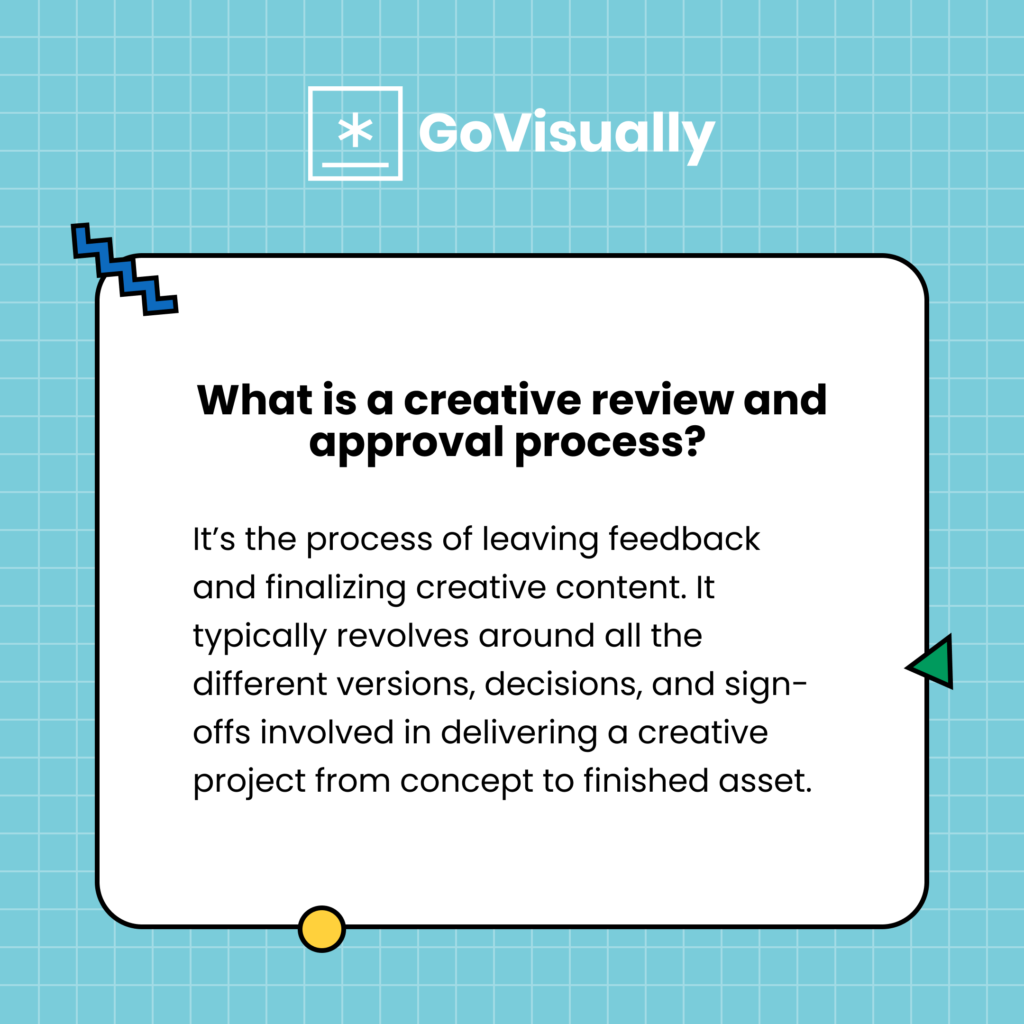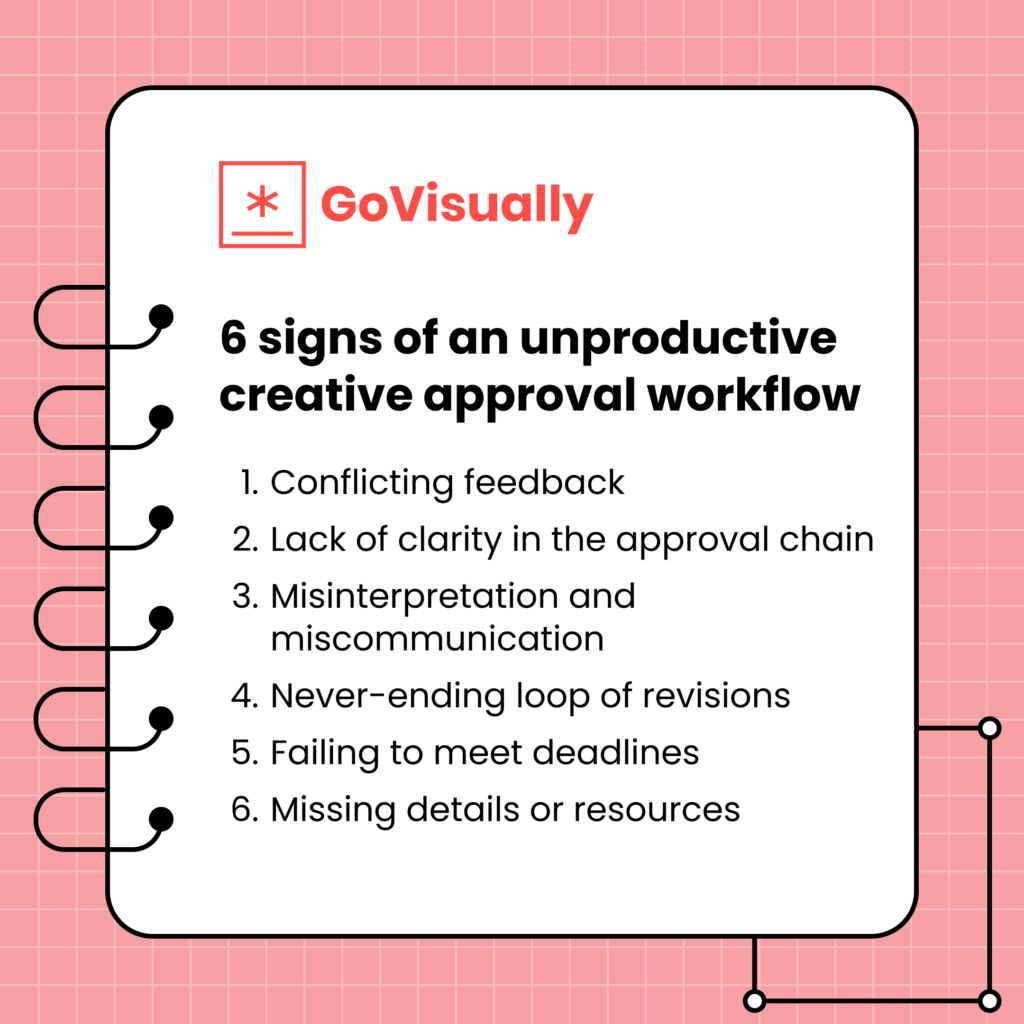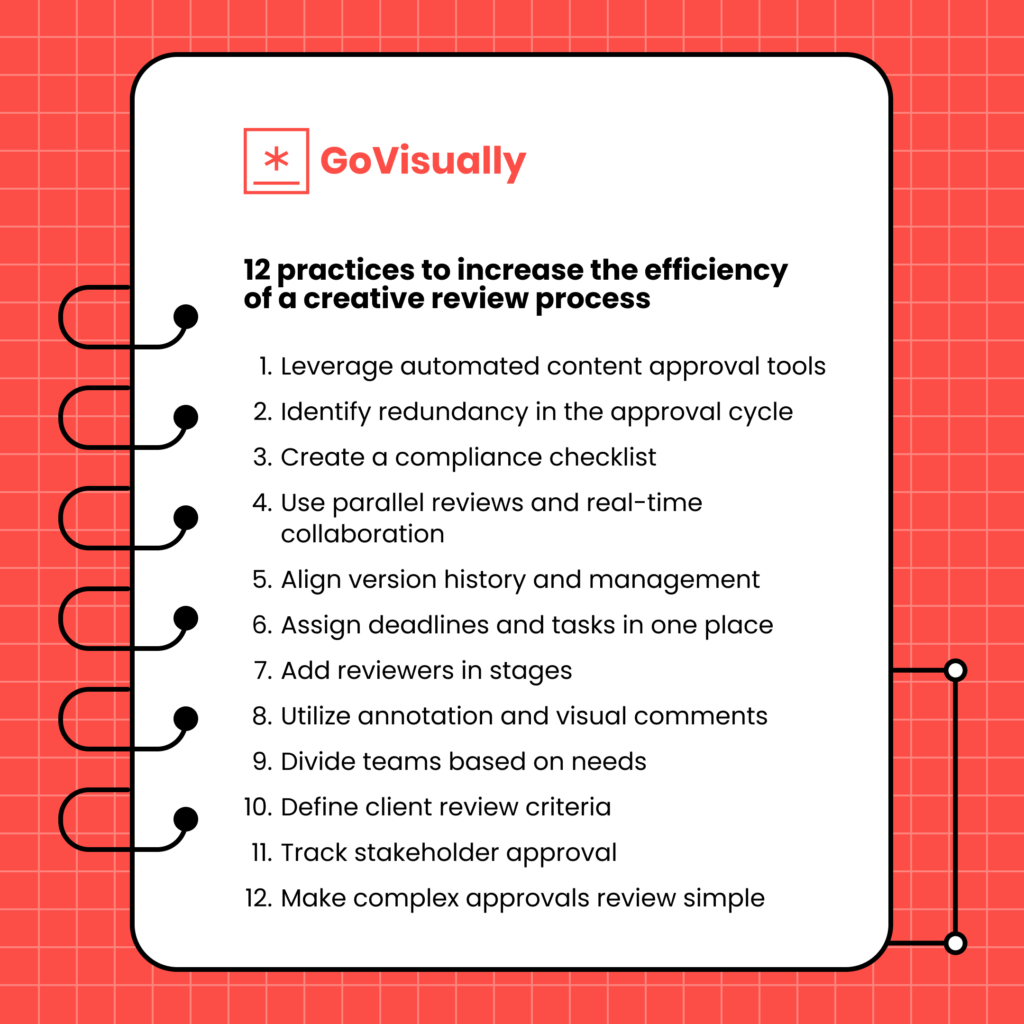Successful projects require a harmonious flow between the review and approval process.
Whether seeking client input on branding guidelines or ensuring the right fonts and colours, approval cycles play a crucial role for all creative teams.
Most organizations have an existing creative approval workflow in place. However, sometimes this process can be slow and frustrating, leading to missed deadlines, lost business opportunities, and low productivity during work.
To help you determine the most effective approval workflow, we have gathered the tried and tested strategies from the experts’ den.
So let’s find out!
Table of Contents
What is a creative review and approval process?
The creative review and approval work together to leave feedback and finalize creative content. It typically revolves around all the different versions, decisions, and sign-offs involved in delivering a creative project from concept to finished asset.

The process usually goes like this:
- You submit the first version of your content.
- Reviewers give you feedback.
- You and your team make any changes requested.
- You keep submitting different versions until everyone has approved it.
While it sounds straightforward, many businesses carry out this process through emails or other communication channels. This often leaves them with disorganized and long chains of messages with repetitive, mismatched, or wrong feedback.
Why is it important to make your creative approval workflow more efficient?
To be successful as a creative organization, you need to move as quickly and effectively as possible.
Faster feedback and approval allow you to get things done more quickly. You can align your work with your goals and stay consistent with your collaborators. This is especially true for remote or hybrid teams that work away from the office.
Fine-tuning your approval workflow and implementing the best practices can help reduce communication and collaboration delays. It will also speed up project delivery, improve client satisfaction, encourage better teamwork, and increase your revenue as a collective result.
But how would you know whether your approval workflow is actually working?
6 signs of an unproductive creative approval workflow
There will be signs. You can tell apart a failing creative review process the same way you can see the impact of a good one.
Some of the most common and easy to mark signs are:

1. Conflicting feedback
Let’s consider video review and approvals for a moment. You’re editing frame-by-frame, but your clients will only review the final product at once. Add sending different versions through scattered emails, and it spells a disaster.
Chances are your clients and even you keep forgetting previous feedback and making the same yet different changes about ten times. If that happens often, it’s time to rethink your approval workflow.
2. Lack of clarity in the approval chain
Who’s reviewing what?
Where do I send this version(12.pdf at?
How do I find what shade of blue the client asked for?
If you or your team encounter similar questions almost daily, your approval chain is a mess. No task management, asset management, or version history is being tracked in a consolidated platform that everyone can access.
3. Misinterpretation and miscommunication
This sign becomes more obvious with time. If your in-team or client communication leaves room for doubts, faulty execution of instructions, and missing edits, you need a better review and approval process.
4. Never-ending loop of revisions
Revisions are inevitable, especially during document review and approval.
However, when your team falls into a never-ending loop of revision, frantically making changes, the blame often goes to team ethics or clients. While most of the time, the real culprit is an inefficient approval process.
5. Failing to meet deadlines
For many creatives, sticking to deadlines can be difficult. An occasional extension doesn’t hurt anyone, and clients usually agree. But if meeting deadlines become a day-to-day struggle, it might be due to unproductive collaboration within the team and disorganized feedback from stakeholders and managers.
6. Missing details or resources
It’s one of the most overlooked signs. Yet it’s also the most damaging.
Losing brand assets provided by the client means losing trust. Imagine adding the wrong logo or brand color to your creative project only to realize that much later. Not only will you lose credibility, but you will also spend precious time looking for details, resources, and instructions scrolling back through email chains.
12 practices to increase the efficiency of a creative review process
You have your answer if you already see a few of these signs. Now you know that your approval workflow isn’t working at all.
But don’t worry, we got you covered with the best practices from fellow expert creatives!

1. Leverage automated content approval tools
In the era where technology is taking over businesses and making everything from video to document review and approval easier if you’re not looking for automation software, you’re missing out.
A range of leading workflow management software can automate your approval cycles with reminders and deadlines to ensure everything stays in place. If you’re not already using one, it’s high time you start doing so!
2. Identify redundancy in the approval cycle
Some creative teams may overlook the impact of deciding which steps to skip for their workflow stages. Skipping certain stages may help keep a project moving along more quickly.
If you’re trying to create a review and approval process for your content, it’s important to consider how to structure the stages so that the work is done quickly and without unnecessary steps.
Sometimes, a review process may work for one version of the same content but add extra time and steps when repeated for different versions. For example, reviewing blog content and videos on the same content can be entirely different.
3. Create a compliance checklist
A compliance management workflow checklist can help ensure that all the necessary information is gathered before a review occurs. It can be used for branding, legal, strategic, or procedural guidelines.
It helps reviewers ensure that all the information is accurate and complete and that the submission is well-organized.
Additionally, a checklist can help identify any areas of concern that may need to be addressed before a review can continue or even begin in detail. Like overlooking a guideline or missing a part of it.
4. Use parallel reviews and real-time collaboration
The most time consuming part of a review and approval process is bringing a teammate, client, manager, or stakeholder back into the process.
A parallel review is when you have multiple or all stages in the workflow going on at the same time. So all team members, clients, and stakeholders are reviewing different aspects of a project simultaneously, similar to in-person collaborative reviewing.
Real-time collaboration and parallel reviews can be game changers for complex approval reviews. Especially when getting a design or video review and approvals from remote teams. This is also where a content approval tool becomes crucial since it makes parallel real-time reviews possible digitally.
5. Align version history and management
For your content to be published, it must go through multiple rounds of review and feedback. And, because there are multiple versions of the document, the process can easily become messy. That’s where review and approval software comes in handy.
In some of the leading tools, all the document versions are organized in the cloud and can be searched for easily, so everyone involved in the review process knows which version is the latest. And, if someone opens an older version of the document by mistake, they’ll be alerted to that fact.
6. Assign deadlines and tasks in one place
Your approval cycle goes beyond simply seeking feedback. Whether it’s getting the project finished in the first place, having in-team communication to finalize a version, or getting client buy-in later in the process, reviews and approvals apply everywhere in your workflow.
In fact, 89% of creatives say they’d prefer a more efficient approval process that consolidates feedback, deadlines, and tasks in one place.
Utilizing tools that integrate into task management platforms, send out automated deadline alerts, and streamline workflow can help you win more productivity than any other tactic!
7. Add reviewers in stages
Determining different review stages for each project segment ensures that nothing gets overlooked. You can divide crucial milestones into review stages and identify who needs to review what and when.
Remember that adding one reviewer to foresee all stages is necessary during a multi-stage approval process and can greatly impact the outcomes. In most cases, a creative director takes this role to ensure every stage is being completed effectively.
8. Utilize annotation and visual comments
For creative teams that work on more visual projects rather than document review and approval, tracking feedback and changes in color, copy, style, fonts, and other design features can be difficult.
Again, a visual annotation tool or advanced feedback software will be crucial to redefine your approval process. By adding annotations or visual comments as feedback, you can quickly see which areas need revision and track the progress of your feedback.
Additionally, this feature makes it easy for reviewers to provide feedback on the document rather than emailing or communicating with you separately. This also reduces the chances of conflicting, repetitive, or incomprehensible feedback.
9. Divide teams based on needs
To configure your digital review stages, you must decide how teams should be segmented. This will help you determine which reviewers should belong to which review group and at which stage in the process.
However, this shouldn’t be done by specific roles or expertise. Instead, segment groups based on what they need and what is essential during their part of the creative project.
For example, if your web designers communicate with copywriters frequently, you may want to put them in the same review group so they can collaborate. If you separate them into different groups will negatively impact how the design and content turn out in the end and make the process less productive.
10. Define client review criteria
When clients give feedback on projects, they can sometimes be vague or unspecific. This can lead to disagreements and confusion.
You can tackle this by creating an approval cycle with client review criteria in mind, requiring specific, contextual, and actionable feedback. In this way, everyone involved knows what the project is supposed to achieve, and they understand the input of other team members.
This could mean adding client approvals for design choices beforehand or seeking feedback on drafts during the early stages. Visual annotation tools and comments also play an important role in making feedback more specific and actionable.
11. Track stakeholder approval
For each review round, you need to track which versions of content have been approved. This will help you see which content is ready to publish and which still needs work.
It will also help you keep stakeholders accountable for the content they approve. You will easily spot which reviewers are delaying the process and what changes they asked for that may lead to extended deadlines.
12. Make complex approvals review simple
Improving your review and approval process for better productivity isn’t about making things more complex. Quite the contrary. It’s about making things as simple as you can while they stay effective.
With all the other tactics outlined above, you might worry about looking for 12 different tools and software that can make things happen as they should. But that will be more counter-productive than anything.
To make things simple, there should be one simple solution. And we have it for you!
GoVisually – the #1 review and approval software for creative teams
GoVisually is an online proofing, workflow management, collaboration, and communication software all in one place, designed specifically to meet the needs of creative teams.
The platform helps you to collaborate and work more efficiently. You can use it to communicate with all the stakeholders on one platform, review and edit documents in real time, and track your team’s progress.
It has a straightforward sign-up method and a shareable link to get third-party feedback and approvals. Neither you nor your clients have to be tech-savvy to use it.
With features that accommodate all types of creative teams and cover all stages of approvals, GoVisually is the leading one-stop solution that redefines creative workflows.
Start your free trial and experience how you can redefine your creative workflow and enhance your team’s productivity with a single platform!




